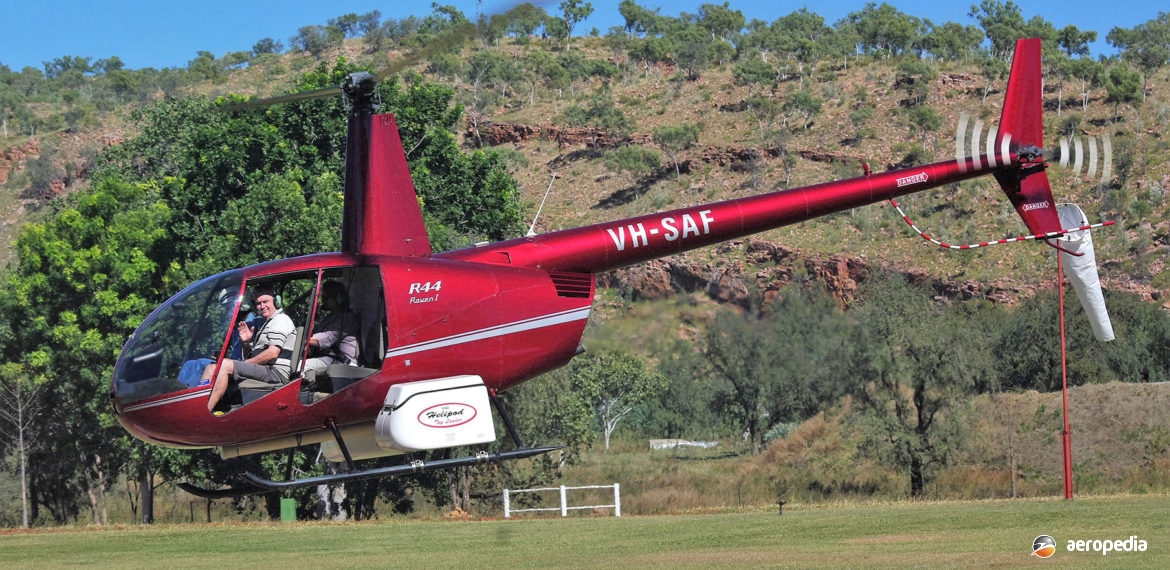Photograph:
Robinson R-44 VH-SAF (c/n 1828) at El Questro ,WA in June 2010 (David C Eyre)
Country of origin:
United States of America
Description:
Four-seat utility helicopter
Power Plant:
One 194 kw (260 hp) Textron Lycoming O-540-F1B six-cylinder horizontally-opposed air-cooled engine de-rated to 168 kw (225 hp)
Specifications:
- Rotor diameter: 10.06 m (33 ft)
- Length: 11.67 m (38 ft 3 in)
- Height: 3.28 m (10 ft 9 in)
- Max cruising speed: 217 km/h (135 mph)
- Max rate of climb at sea level: 305 m/min (1,000 ft/min)
- Ceiling: 4,267 m (14,000 ft)
- Hovering ceiling in ground effect: 2,728 m (8,950 ft)
- Hovering ceiling out of ground effect: 1,372 m (4,500 ft)
- Max range no reserves: 645 km (401 miles)
- Fuel capacity: 69 litres (15.2 imp gals)
- Empty weight: 683 kg (1,506 lb)
- Useful load: 367 kg (810 lb)
- Loaded weight: 1,134 kg (2,500 lb)
History:
The R-44 is a four-seat development of the very successful R-22, more than 2,000 examples of which had been delivered when the R-44 entered production in late 1992.
The prototype R-44 was flown for the first time in March 1990. Three prototypes and a static ground test example were built for the development programme. The type was aimed at a performance and size comparable to that of the Bell Jet Ranger but, being fitted with a piston engine and less equipment, was offered at half the acquisition price and at about a third of the operating cost. To meet the performance targets a number of new design features were required, these including a reduced frontal area to reduce drag, faired landing struts, cowled exhaust and drive train, a fully monocoque tail boom, and an in-house designed heavy duty gearbox.
In order to monitor the type’s entry into service, the first 25 aircraft off the production line were sold to customers close to the Company’s facility at Torrance in Southern California, this making it easier for Robinson to make modifications if necessary in the field to early production aircraft. Certification was received at the beginning of 1993, and deliveries commenced to customers shortly thereafter. First registered in this region became VH-ARG (c/n 0029) in January 1994 and since then more than 100 have been registered in New Zealand and 90 in Australia. The type has been used for a variety of purposes in this region, including training and tourist flights on the Great Barrier Reef, Ayres Rock etc, and the type is certified for firebombing duties with a Bambi bucket.
Further models have been developed, including the R-44 Raven I and II, the latter fitted with a 182 kw (245 hp) fuel injected Textron Lycoming IO-550 engine, this providing an increase in power, an increase in gross weight to 1,130 kg (2,500 lb) and a payload of 370 kg (816 lb). The R-44 Clipper is a float-equipped model, this model having a reduction in cruising speed of 18.5 km/h (11.5 mph) and a decrease in payload of 23 kg (50 lb). The R-44 Mariner is similarly equipped to the R-22 Mariner.
A few have been used for long-distance flights. British pilots Timothy Gilbert and Martin Rutty in an R-44 (G-BXUX) set a record for flying a single-engine piston-powered helicopter from London to Sydney in late 1999, flying the six-weeks, 22,000 km (13,671 miles), 20 country journey raising funds for homeless children. Another R-44 (G-JEFA) was flown around the world by British pilot, Jennifer Murray. In mid-2001 she took third place in the London to Sydney air race with Colin Bodill. More than 500 examples have been operated in this part of the world.

